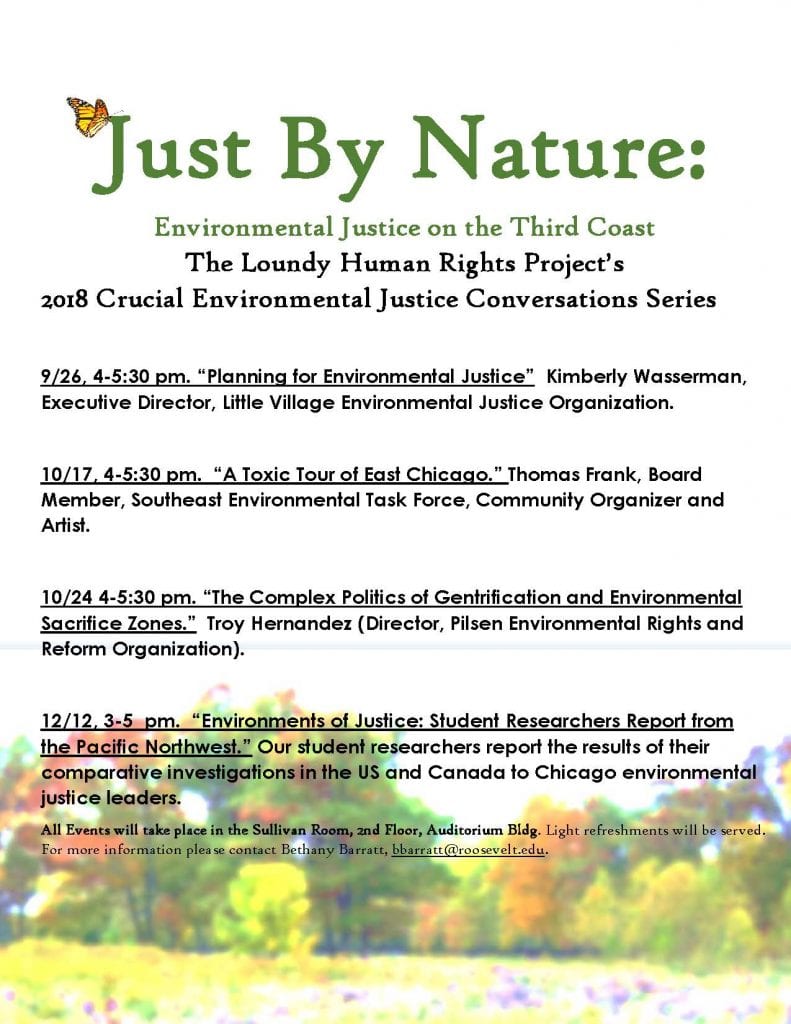

As we wrap up Week 1 of the Fall 2018 semester, I want to extend a welcome to new students in the sociology, sustainability studies, and community development & action programs here @RooseveltU, as well as a “welcome back” to our continuing students. It was great meeting my students in SUST 240 Waste (Wed 2-4:30pm in WB 1215) and SUST 350 Service & Sustainability (Tues 12-13pm @EdenPlace Nature Center and online), and I’m looking forward to a great semester of learning together!
I also want to recognize some of our student leaders this 2018-19 year in our Department of Sociology, Sustainability, & Community Development:
Students, please check back here to get in touch, find my office hours, or tap into my class/writing/research resources. I also recommend subscribing to the sustainability blogs and social media listed on the right, so you can stay up to date on all things sustainable here at Roosevelt. My SUST 240 and 350 classes will be contributing posts to the SUST at RU, RU Green Campus, and Schaumburg’s Sustainable Future blogs this semester.
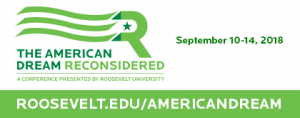 Finally, I look forward to seeing you at the various College of Arts & Sciences events planned for the fall, as well as the landmark American Dream Reconsidered Conference here at RU the week of September 10-14. That will be an exciting week, capped off by our annual Day of Service on Friday 9/14! SUST students, faculty, and alumni will be running a volunteer workday on our 5th-floor Rooftop Garden.
Finally, I look forward to seeing you at the various College of Arts & Sciences events planned for the fall, as well as the landmark American Dream Reconsidered Conference here at RU the week of September 10-14. That will be an exciting week, capped off by our annual Day of Service on Friday 9/14! SUST students, faculty, and alumni will be running a volunteer workday on our 5th-floor Rooftop Garden.
 Just finished up five days of exploring the urban and suburban environment of the Chicago region with my intrepid squad of @RooseveltU students in our one-week-intensive Sustainability Studies 360 course, Writing Urban Nature. Here they are at the North Park Village Nature Center on Chicago’s NW Side, one of the many sites we visited this week in Chicago, Schaumburg, and Will County.
Just finished up five days of exploring the urban and suburban environment of the Chicago region with my intrepid squad of @RooseveltU students in our one-week-intensive Sustainability Studies 360 course, Writing Urban Nature. Here they are at the North Park Village Nature Center on Chicago’s NW Side, one of the many sites we visited this week in Chicago, Schaumburg, and Will County.
From Chicago’s lakefront to its North Side parklands and trails; from South Branch of the Chicago River to the wetlands and woodlands of the NW suburbs; from heritage farms to prairie restoration sites — we visited a wide diversity of places in which to analyze the ever-shifting relations between the natural and built environments in this place that has come to be called “Chicago Wilderness.”
Pictured from L to R here are Austyn (oboe major), Tom (psychology), Alicia (sustainability studies), Grace (wildlife biology), and Denise (biology). Notably, Grace joined our group as a student-at-large from Western State CO University, enrolling in this environmental humanities class via the Resilience Studies Consortium of US colleges and universities. The students now are working on creative non-fiction essays as part of our Writing Urban Nature online project, est. 2015.
Meets May 21-25 from 9:30am to 5pm at RU’s Chicago Campus. Required pre-session on May 9 from 4-6pm, room TBA — videoconferencing also will be provided through Zoom for the pre-session. Some additional work online required. Final writing assignment due June 1st.
Advising and registration are underway for the Summer and Fall 2018 semesters at Roosevelt. Sign up now to get the classes you want! Spaces are still available in our SUST courses, and we’ve got many hands-on learning opportunities for both summer and fall.
RU students: (1) look over the Summer and Fall 2018 schedules using this Coursefinder, (2) check your remaining course requirements in Degree Works, and (3) email or call your assigned academic advisor with your planned schedule and any questions you have about your upcoming classes. Your advisor will provide you with an RU Access registration code so you can register. Click on selected titles below for detailed course previews!
Sustainability Studies courses offered in Summer 2018:
SUST 210 Sustainable Future (online, May 29 – July 25, Prof. Pickren)
SUST 360 Writing Urban Nature (Chicago, one-week intensive, May 22-26, Prof. Bryson)
SUST 390 Rooftop Garden (Chicago, May 29 – July 25, Prof. Gerberich)
Sustainability Studies courses offered in Fall 2018:
SUST 210 Sustainable Future (M, 2-4:30pm, Prof. Pickren)
SUST 210 Sustainable Future (online, 8/27-10/20, Prof. Pickren)
SUST 220 Water (T, 2-4:30pm, Staff)
SUST 230 Food (online, 10/22-12/15, Staff)
SUST 240 Waste (W, 2-4:30pm, Prof. Bryson)
SUST 310 Energy & Climate Change (online, 8/27-12/15, Staff)
SUST 320 Sprawl, Transportation, & Planning (Th, 2-4:30pm, Prof. Pickren)
SUST 330 Biodiversity (Field Museum, Th 9am-1pm, Prof. Kerbis)
SUST 350 Service & Sustainability (Eden Place Farm, T 12-3pm, Prof. Bryson)
SUST 350 Service & Sustainability (online, 8/27-12/15, Prof. Bryson)
SUST 390 Intro to GIS (M 11-11:50am & W, 11am-1pm, Prof. Pickren)
Click on the links above for detailed course previews!
March is a super busy time of the academic year, but don’t neglect getting in touch with your advisor. It’s the best time to get signed up for classes. For additional useful info, see this Advising Resources page on my faculty site as well as this Registration page on the RU website.
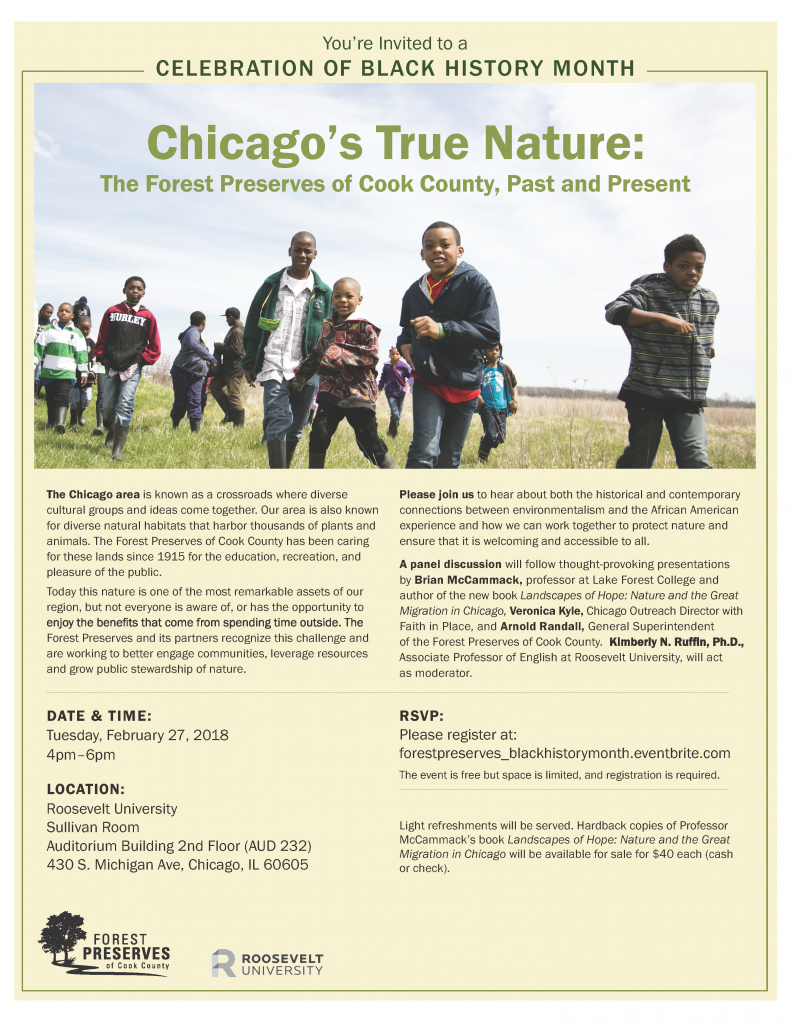 DATE & TIME:
DATE & TIME:
Tuesday, February 27, 2018
4pm –6pm
LOCATION:
Roosevelt University
Sullivan Room
Auditorium Building 2nd Floor (AUD 232)
430 S. Michigan Ave, Chicago, IL 60605
RSVP:
Please register at:
forestpreserves_blackhistorymonth.eventbrite.com
You’re Invited to a Celebration of Black History Month!
The Chicago area is known as a crossroads of diverse cultural groups and ideas. Less commonly known, is the biological diversity of our region. Varied ecosystems are home to native plant and animal species thriving within the Forest Preserves of Cook County.
With nearly 70,000 sprawling acres of wild and wonderful wilderness, the Forest Preserves is a regional asset which improves our quality of life, but not everyone is aware of or has the opportunity to enjoy the benefits that come from spending time outside. The Forest Preserves and its partners recognize the challenge of ensuring that everyone has access to nature and are working to better engage communities of color and grow public stewardship of nature.
Please join us to hear about both the historical and contemporary connections between environmentalism and the African American experience and how we can work together to protect nature and ensure that it is welcoming and accessible to all.
A panel discussion will follow thought-provoking presentations by Brian McCammack, professor at Lake Forest College and author of the new book Landscapes of Hope: Nature and the Great Migration in Chicago, Veronica Kyle, Chicago Outreach Director with Faith in Place, and Arnold Randall, General Superintendent of the Forest Preserves of Cook County. Kimberly N. Ruffin, Ph.D., Associate Professor of English at Roosevelt University, will act as moderator.
Light refreshments will be served. Hardback copies of Professor McCammack’s book Landscapes of Hope: Nature and the Great Migration in Chicago will be available for sale for $40 each (cash or check).
The event is free but space is limited, and registration is required. For directions and transportation information please visit www.roosevelt.edu/campuses/maps-directions
This event is co-sponsored by Roosevelt University and the Forest Preserves of Cook County.
Speaker Bios and Abstracts:
Veronica Kyle directs all of Faith in Place’s Chicago outreach programs, with a particular passion for those related to Sustainable Food and Land Use. She is responsible for the creation of the Migration & Me Program which came about as the result of the realized concern that there were not enough people of color, mainly brown and black people, who were visibly engaged in available extracurricular outdoor activities, stewardship, and Earth care.
Brian McCammack is the author of Landscapes of Hope: Nature and the Great Migration in Chicago (Harvard University Press, 2017) and Assistant Professor of Environmental Studies at Lake Forest College, where he teaches courses on environmental history and politics. Landscapes of Hope recently won the 2018 George Perkins Marsh Prize for best book in environmental history from the American Society for Environmental History. In Landscapes of Hope, he examines the deep connections to nature that black Chicagoans forged in the first half of the twentieth century. The Forest Preserves of Cook County were particularly notable in this regard because African Americans not only sought out leisure there despite racial segregation and intimidation, but the labor of young black men in the Civilian Conservation Corps also helped improve and even build areas like the Skokie Lagoons.
Arnold Randall is the General Superintendent of the Forest Preserves of Cook County. The Forest Preserves of Cook County, established over a century ago, is one of the oldest and largest urban conservation districts in the United States, managing nearly 70,000 acres of diverse habitat across Cook County and offering recreation and education programs for audiences of all ages and from all walks of life. But preserving nature today in the nation’s second largest county comes with its own particular challenges – a lack of funding, climate change, and an urban population often out of touch with nature. The Forest Preserves is actively working with partners to provide a variety of programs that link diverse and urban populations with nature, including a Conservation Corps job training program and robust camping program at five new campgrounds.
Kim Ruffin is an Associate Professor of English at Roosevelt University, author of Black on Earth: African-American Ecoliterary Traditions (U. of Georgia Press, 2010), and nature-loving Certified Forest Therapy Guide.
 I’m honored to deliver a guest faculty lecture at this event today at Roosevelt University. Please come and engage in a meaningful conversation about how food insecurity is prevalent and relates to our community while you learn more about issues of hunger, sustainability and how you can help. Please register for the event here.
I’m honored to deliver a guest faculty lecture at this event today at Roosevelt University. Please come and engage in a meaningful conversation about how food insecurity is prevalent and relates to our community while you learn more about issues of hunger, sustainability and how you can help. Please register for the event here.
 Sponsored by the Black Student Union and the RU Counseling Center, the Oxfam Hunger Banquet provides a chance for us to address the severity of food insecurity and starvation as it relates to our community, and will assist in fostering a community of care that will allow us to join in the fight against inequality, injustice, and oppression. Oxfam is a global organization working to end the injustice of poverty.
Sponsored by the Black Student Union and the RU Counseling Center, the Oxfam Hunger Banquet provides a chance for us to address the severity of food insecurity and starvation as it relates to our community, and will assist in fostering a community of care that will allow us to join in the fight against inequality, injustice, and oppression. Oxfam is a global organization working to end the injustice of poverty.
Here’s a cheerful autumnal thought: advising and registration are now ongoing (since Nov 2nd) for the Spring & Summer 2018 semesters here at @RooseveltU. The Sustainability Studies program is offering a wide range of courses and we’re planning two exciting semesters of learning, research, and campus outreach projects!
Undergraduate students: please look over the Spring 2018 schedule using this coursefinder, check your remaining course requirements, and email or call your assigned academic advisor with your planned schedule and any questions you have about your upcoming classes. Your advisor will help you craft your schedule and provide you with an RU Access registration code so you can register.
Sustainability Studies courses offered in Spring 2018:
ACP 110 Primary Texts (MW 11am-12:15pm, Bryson)*
SUST 210 Sustainable Future (TTh 11am-12:15pm, Pickren)
SUST 220 Water (12-week online, 1/29-4/27, Jones)
SUST 230 Food (W 6-8:30pm, Gerberich)
SUST 240 Waste (8-week online, 3/12-5/14, Gerberich)§
SUST/ACP 250 The Sustainable University (M 2-4:30pm, Bryson)◊
SUST 310 Energy & Climate Change (T 2-4:30pm, Pickren)
SUST 320 Sprawl, Transportation, & Planning (12-week online, 1/29-4/27, Pickren)
SUST 330 Biodiversity (8-week online, 1/16-3/9, Hoffman)§
SUST 340 Policy, Law, & Ethics (Th 2-4:30pm, Hoffman)
SUST 395 Sustainability Studies Internship (by arrangement)
* First Year Seminars are open to new full-time undergrads with 12 or fewer hours in transfer credit.
§ These 8-week accelerated online courses are open to all students and synced with the Flex-Track adult degree calendar. They may be taken back-to-back.
◊ Students may register for either ACP 250 (Grounds for Change credit) or SUST 250 (Sustainability Studies credit).
Sustainability Studies courses offered in Summer 2018:
SUST 210 Sustainable Future (8-week online, 5/29-7/25, Pickren)
SUST 360 Writing Urban Nature (1-week intensive, 5/21-25, Bryson)
SUST 390 Special Topics: Rooftop Garden (on-campus + online, 5/29-7/25, Gerberich)
November is a super busy time of the academic year, but be sure to make a little time to get in touch with your advisor to sign up for the classes you need! My advisees should be sure to check this Advising Resources page here on my faculty website.
Before you email me:
Include in your email:
This fall semester, students in my SUST 220 Water class have been studying our American obsession with bottled water, which comes at the expense of (among other things) proper investment in and maintenance of public drinking water infrastructure. While taxpayer-funded repairs to underground water infrastructure are expensive and politically unpopular, the bottled water industry continues to thrive and grow: the International Bottled Water Association reported industry wholesale revenues of more than $14.2 billion in 2015 alone.
The Chicago Region is blessed with one of the best drinking water sources in the world: Lake Michigan, which supplies water to 163 Chicago-area communities.
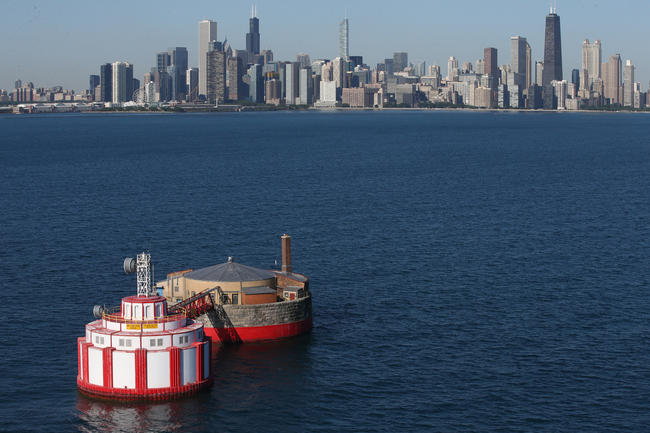
But as this important investigative report published online in the Chicago Tribune reveals, billions of gallons of treated drinking water are wasted each year, while communities pay millions of $ for water that never reaches their taps. Meanwhile, wide disparities in drinking water rates, combined with differential amounts of waste via leaks, disproportionately saddle poor and minority communities with extra costs they cannot afford.
Thus does neglected urban infrastructure meet environmental injustice in 21st century America, here along the southern rim of Lake Michigan.
Sources:
Patrick M. O’Connell, Cecilia Reyes, Ted Gregory and Angela Caputo. (25 Oct 2017). Billions Lost, Millions Wasted: Why Chicago-area Residents Pay Millions for Water that Never Reachers Their Taps. Chicago Tribune. Retrieved from
http://graphics.chicagotribune.com/news/lake-michigan-drinking-water-rates/loss.html.
——. (25 Oct 2017). Same Lake, Unequal Rates: Why Our Water Rates Are Surging — and Why Black and Poor Suburbs Pay More. Chicago Tribune. Retrieved from http://graphics.chicagotribune.com/news/lake-michigan-drinking-water-rates/index.html.
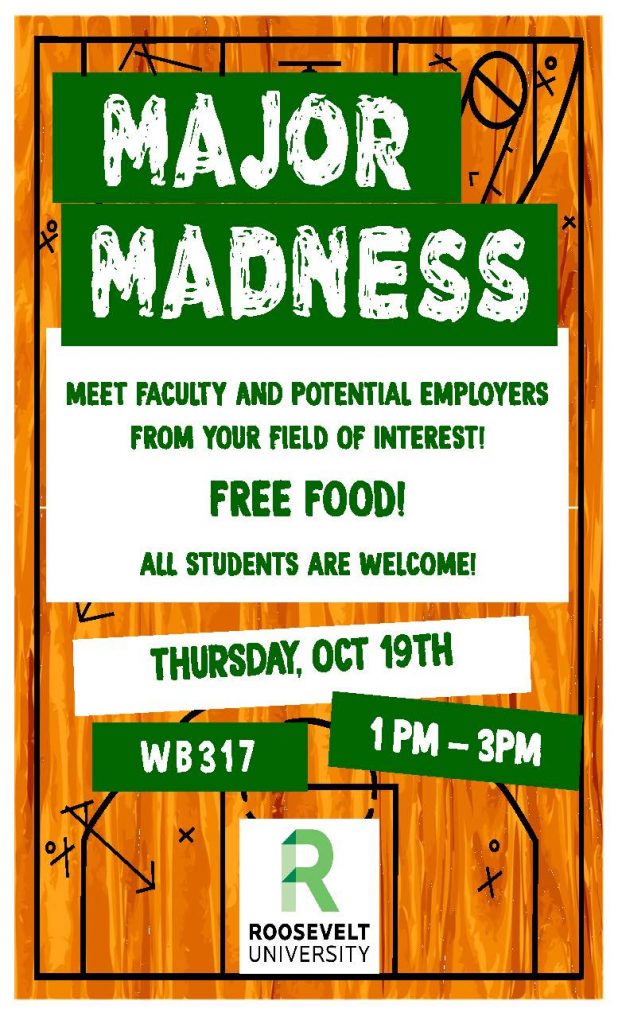 I’ll be attending this upcoming “Major Madness” event (share the pdf of the above poster) as an ACP 101 first year seminar faculty member and as department chair of sociology and sustainability studies. All students are welcome (and my 101 students are required) to attend this event and learn about our various undergrad majors here at Roosevelt. Free food? That’s a nice bonus!
I’ll be attending this upcoming “Major Madness” event (share the pdf of the above poster) as an ACP 101 first year seminar faculty member and as department chair of sociology and sustainability studies. All students are welcome (and my 101 students are required) to attend this event and learn about our various undergrad majors here at Roosevelt. Free food? That’s a nice bonus!